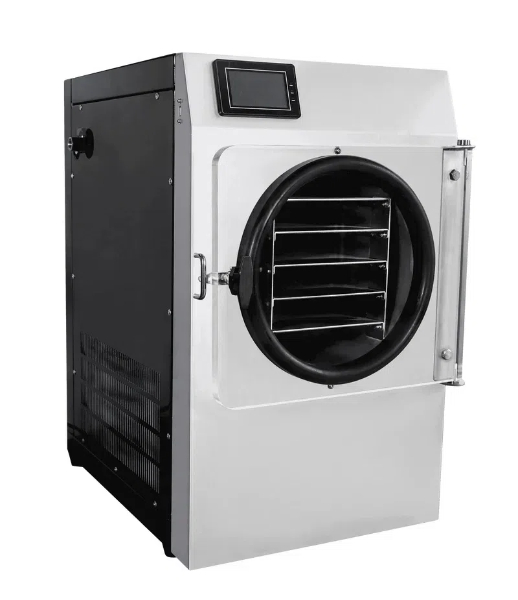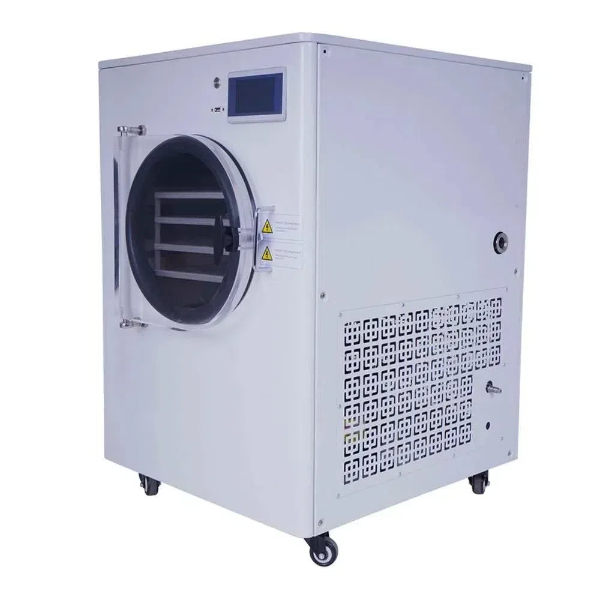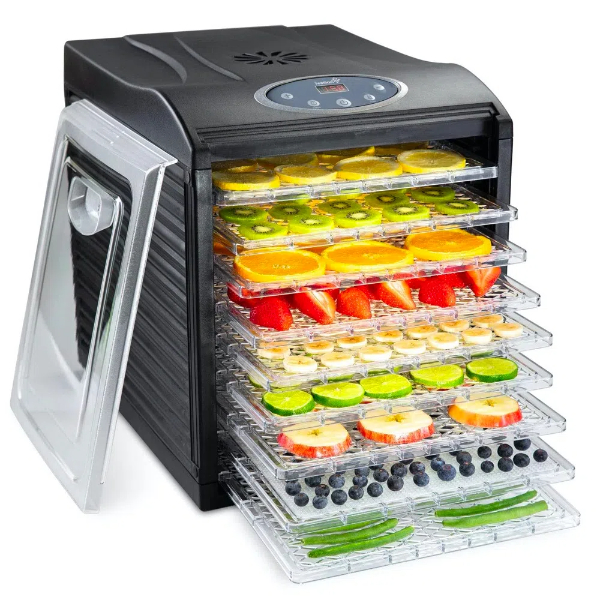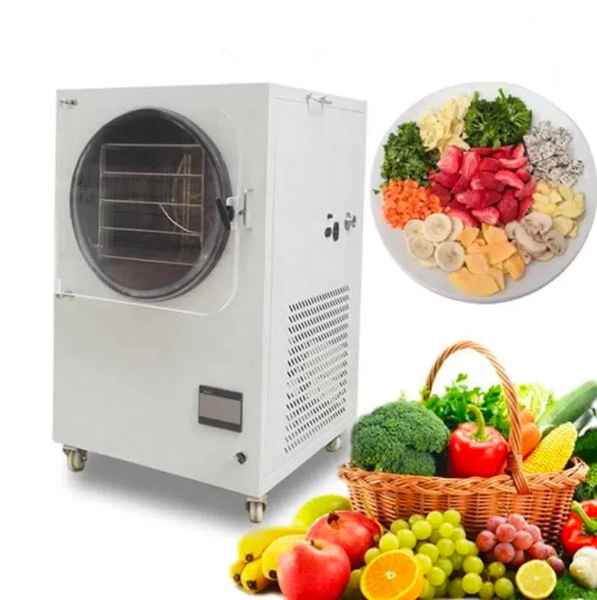
Content Menu
● Introduction to Freeze-Drying Technology
● Understanding the Freeze-Drying Process
● The Rise of Home Freeze Dryers
>> Key Features of Home Freeze Dryers
● Benefits of Using a Food Freeze Dried Machine
>> 1. Extended Shelf Life
>> 2. Nutritional Retention
>> 3. Flavor and Texture Preservation
>> 4. Versatility
>> 5. Space-Saving Storage
>> 6. Cost-Effective in the Long Run
● Choosing the Right Food Freeze Dried Machine
>> 1. Capacity
>> 2. Frequency of Use
>> 3. Energy Efficiency
>> 4. Ease of Use
>> 5. Warranty and Customer Support
● Popular Food Freeze Dried Machine Brands
● Tips for Successful Freeze-Drying at Home
● Exploring Freeze-Dried Food Applications
>> 1. Backpacking and Camping
>> 2. Emergency Preparedness
>> 3. Culinary Experimentation
>> 4. Pet Food
>> 5. Gardening
● The Future of Home Food Preservation
● Conclusion
● Frequently Asked Questions
>> 1. How long does the freeze-drying process take?
>> 2. Can all types of food be freeze-dried?
>> 3. How do I rehydrate freeze-dried food?
>> 4. Is freeze-dried food as nutritious as fresh food?
>> 5. How much electricity does a home freeze dryer use?
Introduction to Freeze-Drying Technology
In recent years, freeze-drying technology has gained significant popularity among food enthusiasts, preppers, and health-conscious individuals. At the heart of this revolution is the food freeze dried machine, a remarkable appliance that has transformed the way we preserve food at home. This comprehensive guide will explore the ins and outs of freeze-drying, its benefits, and how you can harness this technology to enhance your food preservation efforts.
Understanding the Freeze-Drying Process
Freeze-drying, also known as lyophilization, is a sophisticated food preservation technique that removes moisture from food while maintaining its structure and nutritional value. The process involves three main stages:
1. Freezing: The food is rapidly frozen to temperatures between -30°F and -50°F (-34°C to -45°C).
2. Primary Drying: A vacuum is created, and the frozen water in the food sublimates directly from ice to vapor.
3. Secondary Drying: Any remaining moisture is removed through desorption.
This process results in food that is lightweight, shelf-stable, and easily rehydrated without losing its original flavor, texture, or nutritional content.
The Rise of Home Freeze Dryers
While freeze-drying was once limited to industrial and scientific applications, the advent of home freeze dryers has made this technology accessible to everyday consumers. Companies like Harvest Right have pioneered the development of compact, user-friendly freeze dryers designed for home use.
Key Features of Home Freeze Dryers
Modern home freeze dryers come equipped with a range of features that make the process simple and efficient:
1. Digital control panels for easy operation
2. Multiple trays for batch processing
3. Built-in vacuum pumps
4. Automatic defrost and cleaning cycles
5. Various size options to suit different needs

Benefits of Using a Food Freeze Dried Machine
Investing in a food freeze dried machine offers numerous advantages for home food preservation:
1. Extended Shelf Life
Freeze-dried foods can last up to 25 years when properly stored, making them ideal for long-term food storage and emergency preparedness.
2. Nutritional Retention
Unlike other preservation methods, freeze-drying retains up to 97% of the food's original nutritional value, ensuring you get the most out of your preserved foods.
3. Flavor and Texture Preservation
Freeze-dried foods maintain their original flavor profiles and rehydrate to a texture very similar to their fresh counterparts.
4. Versatility
A wide range of foods can be freeze-dried, including fruits, vegetables, meats, dairy products, and even complete meals.
5. Space-Saving Storage
Freeze-dried foods are lightweight and compact, requiring less storage space than canned or frozen alternatives.
6. Cost-Effective in the Long Run
While the initial investment in a freeze dryer may be significant, it can lead to substantial savings on high-quality, long-term food storage over time.
Choosing the Right Food Freeze Dried Machine
When selecting a food freeze dried machine for your home, consider the following factors:
1. Capacity
Determine how much food you plan to freeze-dry regularly. Home freeze dryers typically come in small, medium, and large sizes, with capacities ranging from 4 to 16 pounds of fresh food per batch.
2. Frequency of Use
If you plan to use your freeze dryer frequently, opt for a model with durable components and efficient operation.
3. Energy Efficiency
Look for models with energy-saving features to minimize operating costs.
4. Ease of Use
Choose a machine with user-friendly controls and clear instructions for operation and maintenance.
5. Warranty and Customer Support
Invest in a freeze dryer from a reputable manufacturer that offers a solid warranty and reliable customer support.

Popular Food Freeze Dried Machine Brands
Several brands have established themselves in the home freeze-drying market:
1. Harvest Right: Known for their range of home freeze dryers in various sizes and finishes.
2. Labconco: Offers both benchtop and floor-standing freeze dryers for home and small-scale commercial use.
3. Freeze Dry Machine: Provides compact freeze dryers suitable for home and small business applications.
Tips for Successful Freeze-Drying at Home
To get the most out of your food freeze dried machine, follow these tips:
1. Pre-freeze foods when possible to reduce overall processing time.
2. Cut foods into uniform pieces for even drying.
3. Avoid overloading trays to ensure proper air circulation.
4. Use appropriate packaging materials, such as mylar bags with oxygen absorbers, for long-term storage.
5. Label and date all freeze-dried foods for easy inventory management.
6. Regularly maintain your freeze dryer according to the manufacturer's instructions.
Exploring Freeze-Dried Food Applications
The versatility of freeze-dried foods extends beyond simple preservation. Here are some creative ways to incorporate freeze-dried products into your lifestyle:
1. Backpacking and Camping
Lightweight, nutrient-dense freeze-dried meals are ideal for outdoor adventures, providing sustenance without weighing down your pack.
2. Emergency Preparedness
Create a comprehensive emergency food supply with a variety of freeze-dried fruits, vegetables, meats, and complete meals.
3. Culinary Experimentation
Use freeze-dried ingredients to add intense flavors and unique textures to your culinary creations, from powdered fruit toppings to crunchy vegetable garnishes.
4. Pet Food
Prepare healthy, preservative-free pet treats and meals using freeze-dried meats and vegetables.
5. Gardening
Preserve excess harvest from your garden for year-round enjoyment and reduce food waste.
The Future of Home Food Preservation
As technology continues to advance, we can expect to see further innovations in home freeze-drying equipment. Future developments may include:
1. Increased energy efficiency
2. Faster processing times
3. Integration with smart home systems
4. More compact designs for smaller kitchens
5. Enhanced user interfaces for easier operation
The food freeze dried machine has already revolutionized home food preservation, and its potential for future growth and improvement is exciting for food enthusiasts and preparedness-minded individuals alike.
Conclusion
The food freeze dried machine has opened up a world of possibilities for home food preservation. By harnessing the power of freeze-drying technology, you can enjoy nutritious, flavorful foods with extended shelf lives while reducing food waste and saving money in the long run. Whether you're an avid gardener, outdoor enthusiast, or simply someone who values food security, a home freeze dryer is a valuable addition to your kitchen arsenal.
As you embark on your freeze-drying journey, remember that practice and experimentation are key to mastering this preservation method. With time and experience, you'll discover the best techniques for preserving your favorite foods and creating delicious, long-lasting meals for you and your family.

Frequently Asked Questions
1. How long does the freeze-drying process take?
Answer: The freeze-drying process typically takes between 20 to 40 hours, depending on the food type, moisture content, and the specific machine being used. Larger batches and foods with higher water content will take longer to process.
2. Can all types of food be freeze-dried?
Answer: While most foods can be freeze-dried, some are better suited to the process than others. Foods with high fat content, such as avocados or fatty meats, may not freeze-dry as well. Foods that freeze-dry exceptionally well include fruits, vegetables, lean meats, dairy products, and cooked meals.
3. How do I rehydrate freeze-dried food?
Answer: Rehydrating freeze-dried food is simple. Add warm or hot water to the food and let it sit for a few minutes until it absorbs the liquid and returns to its original texture. The amount of water and time needed will vary depending on the food type and personal preference.
4. Is freeze-dried food as nutritious as fresh food?
Answer: Yes, freeze-dried food retains up to 97% of its original nutritional value. The freeze-drying process preserves vitamins, minerals, and enzymes better than other preservation methods like canning or dehydrating.
5. How much electricity does a home freeze dryer use?
Answer: The electricity consumption of a home freeze dryer varies depending on the model and batch size. On average, a medium-sized home freeze dryer might use between 1-2 kWh per hour during operation. This translates to approximately $2-$4 per day in electricity costs, depending on your local electricity rates.












